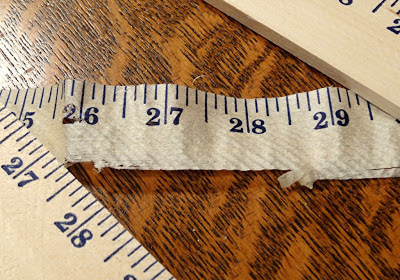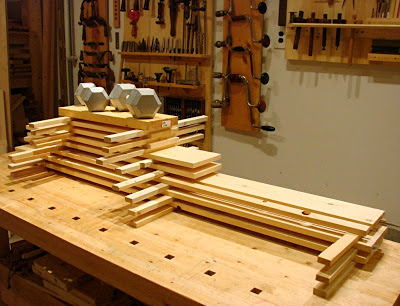One of the things I dislike about not having much time to spend in the shop is how the emphasis shifts to product, rather than process. "I don't have much time!" seems to be followed almost immediately by "I better get this finished!" I've tried to resist this, with limited success, but lately I decided to try a different approach - embrace it.
Hence, this project: The One Hour Stool. The ideas was simple - to see what I could whip up in one hour of shop time. It was fun, and frustrating, but somewhat successful. Let's take a look, with the timer running (times shown are the end of each step).
5' - Dug up some suitable scraps - got lucky with the curved parts left over from
Clara's kitchen.
16' - Smoothed all the "show" faces on stock with smoothing plane (not shown)
20' - Whipped those curves true with the spokeshave.
24' - Added a 1/4" bead to the bottom edge (I didn't know it yet, but planted the seed of failure right here...more about that later).
27' - Stacked the leg blanks together (stepped) and used the drawknife and plane to put a bevel on the legs (top and bottom).
33' - Figured how much narrower the leg stock needed to be in order for the top to have a proper overhang (need that shadow line), and then reduced it down to size with a scrub plane and jack.
37' - Transferred the width dimensions directly from the rails to the legs, used a marking gauge set from the rail thickness to mark the depth, and brought the bevel angle down with a bevel gauge to lay out the notches in the legs for the rails.
43' - Cut the notches in the legs.
44' - All the stock finished. Oh, and somewhere in there I decided to put a bead on the top to ease the arris and to compliment the beaded sides - this took less than one minute (gotta love moulding planes!). But then I decided the legs needed feet, so....
49' - ...feet cut and...
51' - ...smoothed.
61' - I assembled the parts with glue and nails and...
62' - I ripped it apart due to a mistake!
Okay, remember back at 24' I mentioned something about "the seeds of failure"? Well, here's what happened. When I smoothed the curved ends of the sides I didn't bother to make sure the curves were exactly the same at opposite ends. I figured that as the sides were ganged together, the curves at each end would match and that opposite ends would be close enough. This probably would have been fine, except when I planed the beads, I didn't plane opposite faces which resulted in one side piece being reversed for assembly and then the opposite ends were paired. I'm not sure I'm making this clear, but trust me, it messed things up because I eyeballed the leg angle and placement by referencing the curve on the side pieces - which no longer matched... so after gluing and nailing I stepped back and "What?!" The whole thing was racked - from below the legs and sides made a trapezoid Hmm. Can't live with that... but with how to take it apart with the nails already set? Hmm.
Well, I solved that problem - I'll share it some other time. Then I had to remake the legs - which was okay because it let me make them longer, which improved the design.
So back on track:
63' (or about 83') - Drilled and pegged the set nail holes.
64' (84') - Done! The final stool.
This was a fun project and I like the lines of the little stool that came out of it. I also learned (relearned actually...) an important lesson about marking stock to keep track of orientation. You can see some of the fall-out from my mistake with the legs - the extra set of nail holes on the left. Oh well, maybe someday someone will have a bit of a puzzle out of that.
I'm going to paint it a happy blue color with milk paint and then let the kids play with it!































































